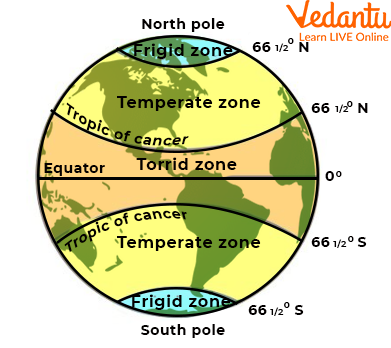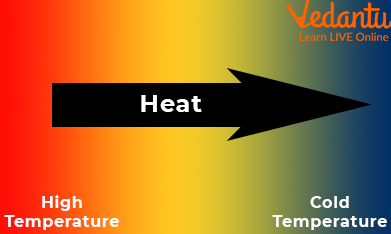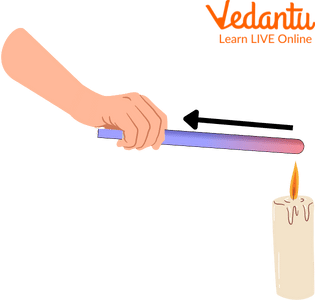




See Heat in Action: Understanding Heat with Step-by-Step Images
Heat is an element of nature that is present almost everywhere. Any object or place we go to has a specific temperature. This temperature can be considered hot or cold as the human body feels it and predicts it. Below is the image of heat energy which helps in the change of temperature.

Different sensations are caused due to the temperature. There is an energy involved in the prediction of temperature. The objects which tend to feel cold and give cooler sensations are said to have less energy while the objects which tend to feel hot and give hot and warm sensations are said to have higher energy.
Understanding Heat Zones with an Image of the Heat Zone of Earth
There are majorly three different zones of the earth that have different heat and temperatures to them. These three zones have significant differences and different properties towards it. Below is the image of heat zones of the earth which depict how temperature affects the earth.

The three major zones are
Torrid Zone
Temperate Zone
Frigid Zone
There are different characteristics within the heat and temperature of the three zones. The three zones have different features, some of which are listed below.
The Torrid Zone
The torrid zone of the earth is hot and has a high temperature. This part of the earth receives the most heat throughout the year since the earth's rays fall vertically on this zone.
The Temperate Zone
The temperate zone of the earth lies between both hemispheres. The temperate zone is further divided into two parts, the north temperate zone, and the south temperate zone. These zones are moderate in temperature, neither hot nor cold.
The Frigid Zone
The frigid zone of the earth is considered the cold zone and is free of heat & high temperature. The cold temperature occurs due to the very less heat received to that area and hence makes it cold.
How Heat Moves?
Heat moves when there is a difference in energy and temperature. Any place where there is a difference in temperature leads to the transfer of heat. The heat and temperature always move from hotter to colder things.

For example, whenever we touch a hot body, there is an exchange of heat and our body feels that area become warm, and sometimes we even get burnt due to the amount of heat exchange.
The heat majorly moves in three ways which are conduction, convection, and radiation. These three different ways are further explained below.
Conduction with the Image of Conduction of Heat
The process of transfer of energy or heat from one particle to another but the medium stays at that same place is called conduction. In simpler words, conduction can be considered as the transfer of heat or charge through a medium or object.

Conduction can easily occur in different states of a medium, be it liquid, solid, or gas.
Conduction occurs when heat is transferred from one molecule to the other when in direct contact with each other.
Although the position between the molecules does not change, instead they vibrate together to transfer the energy.
What is Radiation?
Radiation occurs by the heat waves generated through a body. These heat waves are absorbed by another body whose temperature might be colder or might have less heat. This process of transfer of heat is called Radiation.
For example, the Earth remains warm through the electromagnetic waves produced by the sun. In this case, radiation occurs.
What is Convection?
Unlike conduction, convection involves the motion of particles of any matter for the transfer of heat to occur. Convection involves the movement of particles while changing for heat. This generally occurs in liquid or gas.
Summary
Heat is an important aspect of nature and helps different living beings survive. The major form of heat which helps our earth survive is the sun which transfers us plenty of heat to build our environment and grow. With several forms of transfer of heat present, it makes our work easier and helps transfer energy as and when required.
FAQs on Image of Heat: Explore How Heat Moves and Affects Us
1. What are the different ways heat can travel from one place to another?
Heat energy moves from a hotter region to a colder region through three primary methods as per the CBSE Class 7 Science syllabus for 2025-26. These are:
- Conduction: This is the transfer of heat through direct contact, mainly in solids. For example, a metal spoon gets hot when left in a cup of hot soup.
- Convection: This involves the transfer of heat through the movement of fluids (liquids or gases). When water boils, the hot water at the bottom rises and the cooler water moves down, creating a convection current.
- Radiation: This is the transfer of heat through electromagnetic waves, which does not require a medium. The warmth you feel from the Sun or a bonfire is due to radiation.
2. What is the difference between a clinical thermometer and a laboratory thermometer?
A clinical thermometer is specifically designed to measure human body temperature and has a limited range, typically from 35°C to 42°C. It features a small bend, or kink, in the tube to prevent the mercury or alcohol level from falling back quickly. In contrast, a laboratory thermometer is used for scientific experiments, has a much wider temperature range (e.g., -10°C to 110°C), and does not have a kink, allowing for continuous temperature readings.
3. What are conductors and insulators of heat? Give some examples.
Conductors are materials that allow heat to pass through them easily and quickly. Metals are generally excellent conductors. Common examples include iron, copper, and aluminium. Insulators are materials that resist the flow of heat. They are poor conductors of heat. Examples include wood, plastic, air, and wool.
4. Why do you feel warm when you sit near a bonfire?
You feel warm when sitting near a bonfire primarily because of thermal radiation. The fire releases heat energy in the form of infrared waves. These waves travel through the air and are absorbed by your skin and clothes, which increases their thermal energy and makes you feel warm, even without touching the fire or being directly in the path of rising hot air.
5. Why are the handles of cooking pans made of plastic or wood, while the pan itself is metal?
This design is based on the principles of heat transfer. The main body of the pan is made of metal, a good conductor, to transfer heat efficiently from the stove to the food. The handle, however, is made from an insulator like plastic or wood. These materials do not conduct heat well, which prevents the handle from getting dangerously hot and allows you to hold the pan safely during cooking.
6. How are sea and land breezes created in coastal areas?
Sea and land breezes are natural examples of convection. During the day, land heats up faster than the sea. The air above the land becomes hot and rises, creating a low-pressure area. Cooler, denser air from over the sea flows in to take its place, resulting in a cool sea breeze. At night, the process reverses. The land cools faster than the sea, so the warmer air over the sea rises, and cooler air from the land flows towards the sea, creating a land breeze.
7. Why is it advised to wear light-coloured clothes in summer and dark-coloured clothes in winter?
This advice is related to heat absorption and reflection through radiation. Light-coloured surfaces are poor absorbers and good reflectors of heat. In summer, light-coloured clothes reflect most of the sun's heat, helping to keep our bodies cool. Conversely, dark-coloured surfaces are good absorbers of heat. In winter, dark clothes absorb more heat from the sunlight, helping to keep our bodies warm.
8. On a cold day, why does a metal bench feel colder to touch than a wooden one, even if both are at the same temperature?
This happens because metal is an excellent conductor of heat, while wood is an insulator. When you touch the metal bench, it rapidly conducts heat away from your hand, making your hand feel cold very quickly. The wooden bench, being an insulator, transfers heat away from your hand much more slowly. Therefore, even though both benches are at the same atmospheric temperature, the metal one feels colder due to the faster rate of heat loss from your body.





















